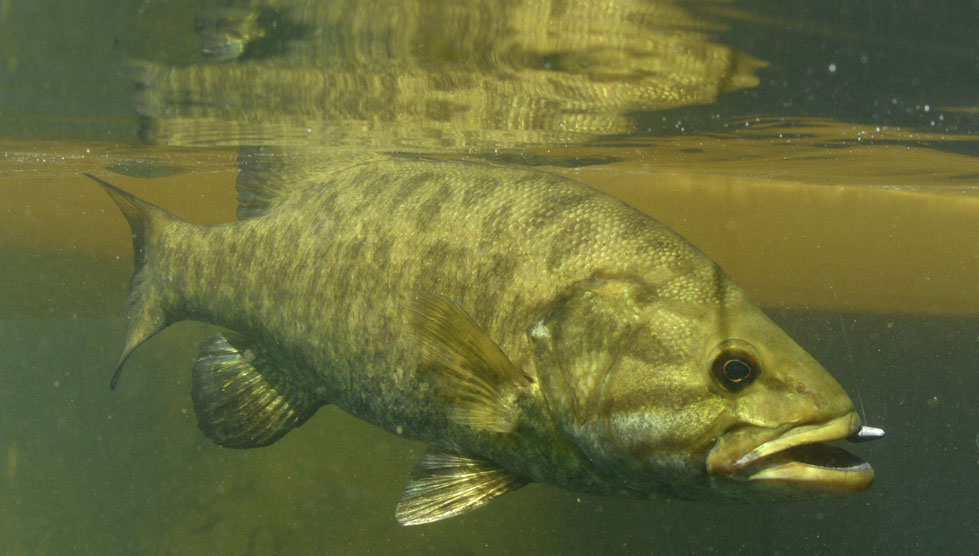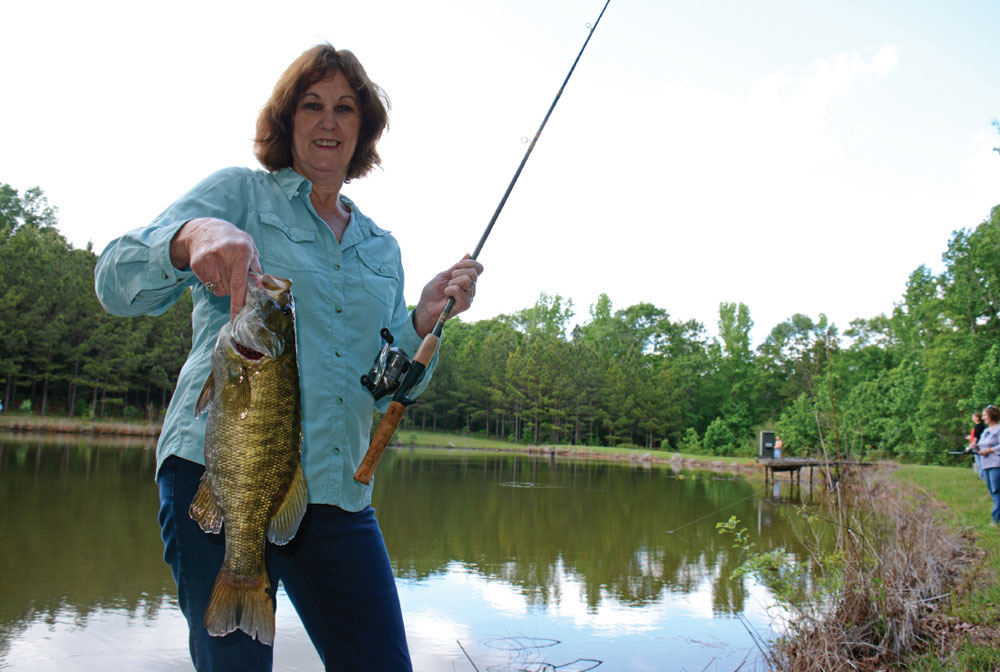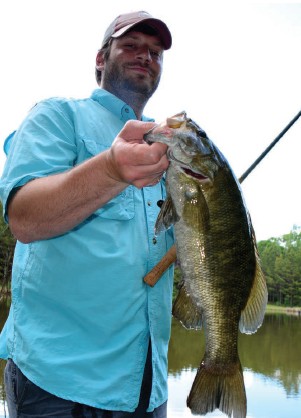Barry Smith
Smallmouth Bass

The smallmouth bass (Micropterus dolomieu) is a species of black bass whose natural distribution runs from southern Canada, through the Saint Lawrence-Great Lakes area, to the upper and middle Mississippi basin, west to eastern Oklahoma, and down through the Tennessee River drainage. It has been introduced by anglers and Game and Fish Agencies into many of the western states including California.
Smallmouth bass are often called bronzebacks or brownies or brown bass because of their brown color. They, as their name implies, have a smaller mouth than the largemouth. With the mouth closed, the end of the jaw does not exceed mid-eye, unlike largemouth bass whose jaw will extend beyond the eye. Smallmouth typically have a vertical barring pattern on their sides and do not have a dark or black lateral line seen in many largemouth bass. As with most fish, color patterns and hue depend on habitat, the darker the water the darker the color pattern. Although the world record smallmouth bass, 11 pounds, and 15 ounces, was caught in Dale Hollow, Tennessee, smallmouth of 4 to 6 pounds are considered a trophy by most anglers.
Smallmouth are known for their aerial antics and are touted by many anglers as the strongest of the black basses, inch for inch and pound for pound. Most of us have read or heard of catching big “smallies” in the Great Lakes or other prime smallmouth areas, but what about ponds? It is commonly thought that smallmouth need deep rocky shores, running water, and cool-water habitats, certainly not the conditions that you would have in your pond! Well, surprise, surprise! Smallmouth bass can live and grow in shallow, red-clay ponds in places like central Alabama. Although the scientific literature suggests their prime growing temperature is 80-85 degrees F, their growth and survival are not limited by the higher temperatures found in the Southeast.
Don Keller, Co-founder of American Sport Fish and Certified Fisheries Biologist says, “Smallmouth that are in environments with dominant predators such as largemouth bass or spotted bass are relinquished to occupying habitat that is not preferred by the dominant predators. The largemouth bass is the king of the pond environment and slow-moving shallow lakes.”
Smallmouth bass can survive summer temperatures in the mid-nineties. “We have kept smallmouth brood fish in our ponds where sometimes summer temperatures exceed 95 degrees,” says Keller. Smallmouth brooder were kept in ponds at Auburn University and the Marion Fish Hatchery in Alabama for several years without summer mortality.
What about ponds?

Bob Lusk, founder of Pond Boss magazine and nationally renowned fishery consultant, has stocked smallmouth bass in ponds from Texas to Arizona. “Introducing smallmouth in ponds containing a spawning population of large-mouth bass is a recipe for disaster,” says Lusk. “Not only is a largemouth more suited to a pond environment, with its bigger mouth, but it is also difficult for another species of black bass to compete with it. Many ponds may be suitable for the growth and survival of smallmouth bass if properly stocked,” claims Lusk. “Smallmouth only and a combination of forage that will not overpopulate the pond is a key. We have experienced survival and growth in shallow soft-water ponds with low alkalinities, no rocks, or moving water! In most of these ponds, we have not experienced natural reproduction. We have seen reproduction in ponds with high alkalinity, but I prefer no reproduction so that we can control recruitment (natural fingerling production) by supplemental stocking,” says Lusk.
Luke Moren, a fisheries biologist with Southeastern Pond Management in their Jackson, Tennessee office has reported success stocking smallmouth bass in ponds in Tennessee and West Virginia.
“We have clients with multiple ponds on their property who want to develop a unique fishery for themselves and their friends and clients. Smallmouth bass have provided this opportunity,” says Moren. “We have tried several different scenarios with success. First, we develop a good forage base using fathead minnows, golden shiners, and red ear sunfish and if the climate is conducive, we add threadfin shad. We prefer to stock advanced smallmouth fingerlings that have been trained on a high protein floating fish pellet and then set up one or more automatic fish feeders to supplement their diet with a similar high protein feed.”
The ponds vary in size and also in physical and chemical characteristics, from one-half to five acres and from soft waters to high alkalinity limestone ponds.
“We have experienced no reproduction to enough reproduction and survival that we need to harvest 12- to 15-inch smallmouth each year to maintain proper balance,” says Moren.
 Robby Mays, co-owner of American Sport Fish in Montgomery, Alabama, and Certified Fisheries Biologist, has spawned smallmouth bass at their hatchery and stocked several ponds in the Southeast.
Robby Mays, co-owner of American Sport Fish in Montgomery, Alabama, and Certified Fisheries Biologist, has spawned smallmouth bass at their hatchery and stocked several ponds in the Southeast.
“One of the ponds we stocked and followed in central Alabama was a small, red-clay pond with a maximum depth of seven feet. It had a threadfin shad and bluegill forage base. First-year growth from a 2-inch fingerling was about 10 to 11 inches, significantly slower than what we see with our Tiger Bass (trademarked largemouth bass) but more than adequate for smallmouth. We had no reproduction and added 15 6- to 8-inch feed trained smallmouth during the second year. Growth continued at slightly less than a pound per year but after four and a half years had smallmouth that were approaching four pounds. That is a trophy in most anglers eyes,” claims Mays.
American Sport Fish is no longer spawning and rearing smallmouth bass. “Our market was certainly a unique one, as we were using the Tennessee River strain of the smallmouth bass, but we could not justify our effort and pond space because of the small market size in the southeast. It was a fun project,” says Mays.
There are obvious reasons that smallmouth bass have not been stocked in many ponds, the first of which is the availability of fingerlings. There are only a few hatcheries in the United States that have smallmouth available and the logistics of obtaining a few of those for stocking a small pond can be daunting. A lot of ponds may be prime candidates for establishing a smallmouth bass fishery, but obviously, it is not always an easy task. Contact a fisheries consultant if you are interested in converting one of your ponds or lakes into this unique fishery.































